Allison Bruning's Blog, page 3
September 12, 2016
Nature vs Nurture...What If It's Both?

Nature vs NurtureWhat If It's Both?
 What makes a human being behave the way they do? Why do some people have disabilities and/or are gifted while others do not? These are questions that have been asked by mankind since the dawn of time. The argument of nature versus nurture isn’t a new argument. The idea of nature versus nature began within the discipline of human development in the 16th century (Nesterak, 2015). Nature dictates that a person’s biology and genes are the deciding factor on how a person turns out. They can’t change who they are because they were born that way. Nurture, on the other hand, argues that that a person becomes who they are based on how they react to their environmental influences. Eugenics, the principal of beliefs that aims to improve the genetic disposition of human beings, has been practiced since Ancient Greece. Eugenics has caused many unjust laws and tragedies throughout human history. While genetics does play a part in human development, it doesn’t solely dictate who were are and become. But just how much of role does genetics have in human development?Epigenetics Epigenetics is a fairly new science in human development. Conrad H. Waddington coined the term epigenetics in 1942 to define the scientific study of how environment influences genetic expression (What Is Epigenetics, 2016). Waddington’s approach to the genetic study of humans doesn’t focus so much on how the genes express themselves but what they are doing. Although human beings are born with a certain genetic disposition that allows for personality and biological traits that doesn’t always mean that those traits will be dominant in that child. Genetic Science Learning Center. (2013, July 15) explained there are inactive and active genes within a person’s DNA that are controlled by the epigenome. Our DNA is wrapped around a protein known as histones. Chemical tags lie upon the histone and DNA forming a second layer known as the epigenome. It is the responsibility of the epigenome to shape the physical structure of the genome. The epigenome wraps itself around inactive genes causing them to be unreadable and relaxes around the active genes so they are more easily accessible (Genetic Science Learning Center, 2013). While the epigenome changes a person’s gemone, it is important to know that a person’s DNA never changes. This means while a child carries DNA from both parents, he or she may have some traits from them that may never reveal themselves. The epigentic process is not a one time occurs nor is it always the same. Researchers have identified several different types of the epigenetic process including ubiquitylation, sumolyation, acetylation, methylation, and phosphorylation (Weinhold, 2006). A person’s genomes continue to change throughout their lifespan due to the way they interact with influences. Some of these influencers have been identified as environmental, age, lifestyle and disease (What Is Epigenetics, 2016). Social science research studies have helped us to understand the impact some of these influencers have upon the human development of certain population groups. Societies and individuals have been forced to adapt to their changing world throughout history. Major societal changes, such as war and poverty, can change the way parents rear their young (Collins, 2000). David Moore, (as cited in Nesterak, 2015) found children who remained for a long time within impoverished homes tended to show adverse biological consequences later on in their adulthood. These adverse effects can still be upon these children even if they managed to live a life in middle class during their adulthood. Children who grew up in middle class homes and remained middle class do not suffer from the same adverse effects as their impoverished childhood peers who live in middle class during their adulthood. The epigenetic process allows for humans to adapt to their surroundings and circumstances. If human development was a purely natural phenomenon then we would not be able to adapt to our world. Epigenetic research is not so easily to conduct due to ethical reasons. Genetic researchers would have to conduct biological tests on human subjects in a tightly controlled environment in order to further their research. In order to continue their research without violating ethics, researchers have been using monkeys and rats. (Nesterak, 2015). The results of these studies have furthered the knowledge of epigenetics. Conclusion Nature versus nurture has been a topic of interest throughout the world since the 16thcentury. Some politicians and scholars have advocated for supreme genetic disposition in human development by fully enforcing eugenic laws that have caused human tragedies and injustice. A relatively new science, epigenetics, argues that human development is both nature and nurture. Epigenetic researchers have found humans adapt to their influences through a change in their genomes. More research needs to be conducted in order to understand more about how this adaption process works in human development.
What makes a human being behave the way they do? Why do some people have disabilities and/or are gifted while others do not? These are questions that have been asked by mankind since the dawn of time. The argument of nature versus nurture isn’t a new argument. The idea of nature versus nature began within the discipline of human development in the 16th century (Nesterak, 2015). Nature dictates that a person’s biology and genes are the deciding factor on how a person turns out. They can’t change who they are because they were born that way. Nurture, on the other hand, argues that that a person becomes who they are based on how they react to their environmental influences. Eugenics, the principal of beliefs that aims to improve the genetic disposition of human beings, has been practiced since Ancient Greece. Eugenics has caused many unjust laws and tragedies throughout human history. While genetics does play a part in human development, it doesn’t solely dictate who were are and become. But just how much of role does genetics have in human development?Epigenetics Epigenetics is a fairly new science in human development. Conrad H. Waddington coined the term epigenetics in 1942 to define the scientific study of how environment influences genetic expression (What Is Epigenetics, 2016). Waddington’s approach to the genetic study of humans doesn’t focus so much on how the genes express themselves but what they are doing. Although human beings are born with a certain genetic disposition that allows for personality and biological traits that doesn’t always mean that those traits will be dominant in that child. Genetic Science Learning Center. (2013, July 15) explained there are inactive and active genes within a person’s DNA that are controlled by the epigenome. Our DNA is wrapped around a protein known as histones. Chemical tags lie upon the histone and DNA forming a second layer known as the epigenome. It is the responsibility of the epigenome to shape the physical structure of the genome. The epigenome wraps itself around inactive genes causing them to be unreadable and relaxes around the active genes so they are more easily accessible (Genetic Science Learning Center, 2013). While the epigenome changes a person’s gemone, it is important to know that a person’s DNA never changes. This means while a child carries DNA from both parents, he or she may have some traits from them that may never reveal themselves. The epigentic process is not a one time occurs nor is it always the same. Researchers have identified several different types of the epigenetic process including ubiquitylation, sumolyation, acetylation, methylation, and phosphorylation (Weinhold, 2006). A person’s genomes continue to change throughout their lifespan due to the way they interact with influences. Some of these influencers have been identified as environmental, age, lifestyle and disease (What Is Epigenetics, 2016). Social science research studies have helped us to understand the impact some of these influencers have upon the human development of certain population groups. Societies and individuals have been forced to adapt to their changing world throughout history. Major societal changes, such as war and poverty, can change the way parents rear their young (Collins, 2000). David Moore, (as cited in Nesterak, 2015) found children who remained for a long time within impoverished homes tended to show adverse biological consequences later on in their adulthood. These adverse effects can still be upon these children even if they managed to live a life in middle class during their adulthood. Children who grew up in middle class homes and remained middle class do not suffer from the same adverse effects as their impoverished childhood peers who live in middle class during their adulthood. The epigenetic process allows for humans to adapt to their surroundings and circumstances. If human development was a purely natural phenomenon then we would not be able to adapt to our world. Epigenetic research is not so easily to conduct due to ethical reasons. Genetic researchers would have to conduct biological tests on human subjects in a tightly controlled environment in order to further their research. In order to continue their research without violating ethics, researchers have been using monkeys and rats. (Nesterak, 2015). The results of these studies have furthered the knowledge of epigenetics. Conclusion Nature versus nurture has been a topic of interest throughout the world since the 16thcentury. Some politicians and scholars have advocated for supreme genetic disposition in human development by fully enforcing eugenic laws that have caused human tragedies and injustice. A relatively new science, epigenetics, argues that human development is both nature and nurture. Epigenetic researchers have found humans adapt to their influences through a change in their genomes. More research needs to be conducted in order to understand more about how this adaption process works in human development. ReferencesCollins, W. A., Maccoby, E. E., Steinberg, L., Hetherington, E. M., & Bornstein, M. H. (2000).
Contemporary research on parenting: The case for nature and nurture. American Psychologist, 55, 218–232.
Genetic Science Learning Center. (2013, July 15) The Epigenome at a Glance. Retrieved September 09, 2016, from http://learn.genetics.utah.edu/conten...
Nesterak, E. (2015, July 10) The End of Nature Versus Nurture. The Psych Report. Retrieved from http://thepsychreport.com/books/the-end-of-nature- versus-nurture/
Weinhold, B. (2006, March) Epigenetics: The Science of Change. Environ Health Perspect. 114(3), A160-A167. Retrieved from http://www.ncbi.nlm.nih.gov/pmc/artic...
What is Epigenetics? (2016) Epigenetics: Fundamentals. Retrieved from http://www.whatisepigenetics.com/fund...
Published on September 12, 2016 15:35
September 6, 2016
Ohio's Archaic Heritage: Stone Tools #history #nativeamerican
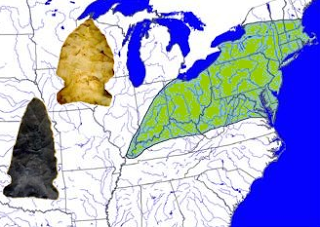 Ohio's Archaic Heritage
Ohio's Archaic HeritageKnives, Points, Axes and Scrapers
The Archaic Period is divided up into three stages. These are: Early (8000B.C.E. - 6000 B.C.E.), Middle (6000 B.C.E. -3500 B.C.E.), and Late (4000 B.C.E. -1500 B.C.E.). Sometimes historians and scientists will add a Terminal Stage between (1500 B.C.E.–700 C.E.) This end stage overlaps the Woodland Period. We will be talking about this period in our next series. Early Archaic life resembled a Paleoindian culture as small groups continued to life the Paleoindian nomadic lifestyle. It isn't until the Middle Archaic Period where some of these groups start to develop a more sedetary lifestyle. The change from nomadic to sedentary did not happen all at once nor was it across the board. This change was gradual and varied from group to group, as did the acceptance of the atlatl.
The Archaic people created knifes, spearheads, scrapers and other tools out of ground stone. They rarely threw their tools away when they became worn. Instead they would reshape the item into something else. The transition from Paleoindian to Archaic was a gradual procession that occurred as the large mammals became extinct and the climate became warmer. As we learned in our last post, the Archaic hunters had to change their hunting methods in order to survive.
Archaic tool kits reflect the change in hunting techniques as they now contain a wide range of ground stone tools that include celts and axes used to cut and work trees, grooved rounded stones to weight fishing nets, spear points, knives, a variety of scrapers, as well as tools and ornaments made of bone, antler, and shell. Another distinction between the Paleoindian and Archaic cultures were their spear points. This was due to the discovery of the atlatl.
Axes, Chisel, Gouges and Adzels
The transition to a sedentary life required that the Archaic to develop new tools that would allow them to work with wood. Woodworking was important for the Archaic people because it allowed them the ability to create shelters, canoes and other daily used items.
The flint they had been using to create their points, drills and other tools was not suitable for woodworking because flint shatters when it hits something hard. The Archaic people used other stones to create their axes, chisels, gouges and adzels. Just like the skilled huntsman, an expert craftsmen was highly valued by his people.
Stone axes were very effective on wood as seen by this video.
Three dugout canoes have been found in different parts of Savannah Lake, Ashland County, Ohio. One of these canoes, dating to 1600 B.C., is 20 feet in length. Savannah Lake is located between the Lake Erie and Ohio River watersheds. This find proves that the Archaic people were using the waterways for travel purposes. The Archaic people fished more than they hunted game so it would make sense for their settlements and activity to be located close to waterways.
Points
The change from a Paleoindian point to an Archaic point did not happen overnight. Archaeologists have identified several "transitional points" that were used in the Archaic Period as the Archaic people began to transition out of their Paleoindian lifestyle.
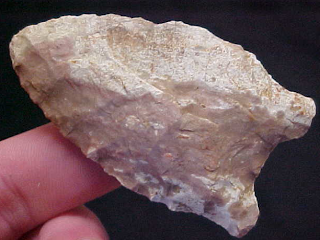 A Paleoindian Spearhead found in Ohio
A Paleoindian Spearhead found in OhioThe images below are of Archaic points that were found at the Falls of Ohio State Park in Indiana. This park sits on the banks of the Ohio River. Many points can be found along the Ohio River. Notice the different sizes and shapes of each spearhead and the progression in time.
 Archaic Points
Archaic Pointshttp://www.fallsoftheohio.org/Fallsof... most famous of all Ohio Archaic Points is a fine example of the Archaic people's resourcefulness.
Known as the Ohio Dovetail, settlers discovered these dovetailed shaped points while plowing their fields. The Ohio Dovetail took on many shapes and sizes. They were usually worn out knives that were reshaped into a spearhead. They are so numerous that they are still being found today. The picture below shows an Ohio Dovetail that was found in Licking County and is currently being sold on EBAY.
 An Ohio Dovepoint
An Ohio Dovepoint Unfortunately many stool tools and points find their way into the market instead of being preserved so everyone can enjoy a piece of cultural history.
Published on September 06, 2016 07:37
September 4, 2016
#AuthorSpotlight: Chasity Tarantino

Welcome to a new section on my blog. It's been awhile since I've had the Author Spotlight up and running on here. I love having the opportunity to help new authors. I've scheduled the Author Spotlight to occur on my website every Wednesday and Sunday. I hope you enjoy learning about the authors and their books.
Meet Chasity Tarantino
 Chasity Tarantino currently resides in Highland, Indiana. Reading has always been a huge passion of hers. There is nothing better than being able to escape reality for a little while and delve into a new world created just for entertainment to her. To her books are golden and they are the most magical thing in this world. She began writing when she was in the fourth grade and has been writing ever since. She is currently attending Ashford University to complete her BA in English. When she is not reading or writing is listening to music, crocheting, or hanging out with her family. She lives with her husband and her doggie Chloe, she considers herself the luckiest girl in the world to have those two who constantly support her and a loving family who have always had her back. Her first published work was a short story named “You’re Still the One” which was featured in an Anthology called, “My Life Would Suck Without You” and her upcoming debut novel, “Warped Love” will be her first full length novel.
Chasity Tarantino currently resides in Highland, Indiana. Reading has always been a huge passion of hers. There is nothing better than being able to escape reality for a little while and delve into a new world created just for entertainment to her. To her books are golden and they are the most magical thing in this world. She began writing when she was in the fourth grade and has been writing ever since. She is currently attending Ashford University to complete her BA in English. When she is not reading or writing is listening to music, crocheting, or hanging out with her family. She lives with her husband and her doggie Chloe, she considers herself the luckiest girl in the world to have those two who constantly support her and a loving family who have always had her back. Her first published work was a short story named “You’re Still the One” which was featured in an Anthology called, “My Life Would Suck Without You” and her upcoming debut novel, “Warped Love” will be her first full length novel.Warped Love Excerpt
Finally after much debate in his own mind, he got up and made his way to the bar.The seat next to her was vacant so he took it and motioned to the bartender, letting him know that he needed a drink. He then glanced at the girl next to him, only to meet her gaze; she was looking right at him. She smiled; then quickly looked back at her drink.He smirked, but she didn’t see it. She was even more beautiful up close. There was definitely no turning back now, he licked his lips and began to say something to her, but before he could get it out the bartender came over and said,“What can I get you?” in a cheery tone.“A gin and tonic, please.” Camden ordered.“Sure thing.” The bartender agreed, heading off to make his drink.“Hi.” Camden whispered in the girl’s direction.She glanced up quickly to see if he was talking to her, when she seen that he was indeed talking to her.“Hi.” She muttered back quietly; then she quickly scanned the bar behind her.Camden thought she looked nervous, maybe even scared. He wondered what that was all about, when she was finally convinced that the area around her was safe, she looked back at Camden.“Having a good time at the party?” He questioned, even though she clearly was not.“Yeah, I really like the band and this new album is really good too.” She nearly whispered, looking at her clutch.So not only was she absolutely gorgeous, but she liked his music and she like it for the actual music, not him. This just got better and better.When he didn’t answer her she asked,“What do think of this band?”
Published on September 04, 2016 05:52
August 29, 2016
#Ohio #Native #Americans: The First People
 Ohio Native Americans
Ohio Native AmericansIn the Beginning
The Shawnee nation are perhaps the most famous of all Ohio tribes but they weren't the only Native American tribal group in the area. The Great Lakes region were home to many small and large tribal groups with their own dialects and cultures. Each of the tribes had their own creation stories of how their ancestors had arrived in the region in which they lived. Oral stories were passed down from generation to generation. Cultural groups have come and gone in Ohio but they left behind archeaological and cultural evidence of their existence. In order to understand the Native American cultural heritage of Ohio we must go back in time and visit upon the tribes who once dwelt within the Buckeye State. We begin our journey during the Paleoindian Period.
The Paleoindian Period lasted from 13,000 -7,000 B.C, which was towards the end of the Late Pleistocene Period. Paleoindian life revolved around the hunting of the great animals and was greatly affected by the Ice Age. The glaciers killed the plant life which meant the herbivores had to migrate elsewhere. Thus humans and the carnivores had to move with the herds into previously unknown territories. Paleoindian groups were highly mobile. Any given band could consist of anywhere between 20-60 members, all of whom were extended family. Hunting and gathering were done during the spring and summer months when smaller hunting parties left the group. These hunting parties would return during the fall and stay throughout the winter. Their diets varied depending on how successful the hunt was. Their clothes and the covers for their shelters were made of animal skins.
The earliest known Native American group to inhabit Ohio was the Clovis Culture. The Clovis Culture appeared around 11,500 B.C. but didn't inhabit Ohio until between 9500 - 8000 B.C. The northern glaciers retracted, exposing new land for exploration and settlement between 17,500 to 14,500 years ago. The animals and Clovis culture took advantage of the new Ohio lands. During the late 20th century, the predominant theory of human colonization of the Americas had been Clovis First, meaning the Clovis Culture were the first group to inhabit the Americas. But scientists and historians are beginning to question the Clovis First theory.
In 2011, archaeologists at the Buttermilk Creek Complex close to Salado, Texas unearthed an occupation that was proven to be older than Clovis. The Buttermilk Creek Complex isn't the only archaeological site that predates the Clovis Culture. The following are a list of sites that predate the Clovis Culture.
Pedra Furada, Piauí, Brazil (55,000 yr BP ABOX)Topper, (at least 22,900 yr BP; possibly 50,000 yr BP but this is disputed) South Carolina, USMeadowcroft, Pennsylvania, US (16,000 yr BP)Cactus Hill, Virginia, US (15,070 14C yr BP)Monte Verde, Chile (14,800 14C yr BP)Saltville, Virginia, US (14,510 14C yr BP)Taima-Taima, Venezuela (14,000 yr BP)Connley Caves, Oregon, US (13,000 yr BP)Page-Ladson prehistory site, Florida, US (12,425 ± 32 14C yr BP [15,405–14,146 cal yr BP])Lapa do Boquete, Brazil (12,070 ±170 14C yr BP)Paisley Caves, Oregon, US (14,300 cal yr BP)Tanana Valley, Alaska, US (13,000–14,000 cal yr BP)Nenana valley, Alaska, US (12,000 yr BP)Tibitó, Colombia (11,740 ±110 14C yr BP)Tagua-Tagua, Chile (11,380 ±380 14C yr BP)
New archeological discoveries and research is starting to shed light on an earlier group of people to inhabit North American known as the Solutreans. The Solutreans were Caucasians tribes that inhabited the Americas. Ohio does not have evidence of this group because at the time of their existence Ohio was under sheets of ice.
Published on August 29, 2016 21:00
August 26, 2016
#CelebratetheSmallThings: #Business and book blessings

This week has been another week of changes for me. My publishing company is growing. As of today, I have eight authors and 15 books slated for release by December 31st. We've only been open since June 27th! I am very impressed with the quality of work our authors have produced and our staff have done. I look forward to seeing ever more from them.
Another great thing has happened for me this week as well. I've had a high fantasy erotica fiction sitting on the shelf for two years. I've posted a few times, over the years, on my blog that I was working on it. I have the story in my head, have plotted it but it's a new genre for me. This week, I teamed up with a new author who writes fantasy. Destiny Blackthorne. My one little story has ended up becoming the beginning of a six book series and the end of that series starts a spinoff. I'm so excited! I'm writing this book at the same time as I'm writing Lies and Deceit. We already have the cover for the first book.

Published on August 26, 2016 12:17
August 21, 2016
Is #Autism a genetic condition? #genetics #disorders #education

One of the most asked questions about Autism (Aspergers Syndrome is on the Autism Spectrum) is whether or not it has is a genetic condition. There are many families where more than one people have been diagnosed with a type of Autism.
Scientists have been interested in determining why Autism seems to run in families. A 2011, a study of 226 infants throughout the United States found parents of an Autistic child may produce more Autistic children. Of the families who were studied 8-10% of Autistic children had siblings who had Autism as well. Nineteen percent of these siblings were younger than their brother or sister. The more children a family had the more likely they were to have Autistic children. Gender seems to make a difference as well. Of the families studied, 26% of boys were Autistic compared to 9% girls. The result of the study strongly proved there may be a genetic condition to Autism.
Published on August 21, 2016 21:00
August 15, 2016
The Exclusion of the ESL Learner in #Gifted #Education Programs

The Exclusion of the English Language Learners
Gifted Education programs are supposed to provide additional educational support to the intellectually gifted student yet not all gifted students are included in such programming. The largest groups to be underrepresented in gifted education programs are English Language Learners and students from impoverished homes. The problem with identifying gifted students from these two subgroups in our American culture is that they don't fit what is traditionally thought of as what a gifted learner should looked like. Educators try their hardest to provide for all their students' educational needs. More often than not, teachers spend more time with students who have a disability than trying to help the gifted child. There is a preconceived notion that the gifted learner will do alright in their grade level without the teacher's extra support.
Educators are often not taught about gifted learners and their needs while taking their coursework to become a teacher unless they specialize in special education. In most schools, gifted learners are expected to learn in a general education classroom. The gifted learner struggles with their classwork because they can easily become bored. A gifted learner doesn't learn like the rest of their peers. Educators are expected to evaluate their students to determine whether or not the student should be referred for testing so they can be included in the gifted education program. The problem is, some teachers will not refer a student because the student's personality doesn't fit what they believe a gifted learner should act like. Most of the time these are students with a disability, ESL and/or come from impoverished homes.

English Second Language
Communication is important. But sometimes it can be hard to communicate with a student whose
language or dialect you don't understand. Gifted ESL students strive harder to learn because they have a language barrier to overcome. Most times, educators will completely ignore a gifted ESL student not because they don't care but because they can't understand what the student is trying to communicate. Here are some tips for educators working with ESL learners.
1) Accept the minor differences in academic writing.
Academic writing is hard for ESL learners because it is not the same as the day to day oral language they are learning from their peers. When working with an ESL student be mindful of the message they are trying to convey. Have the student tell you in their own words what the paper might say.
2) Be gentle when criticizing.
ESL learners may be more sensitive than their peers when it comes to written and oral language. Don't just hand a paper back to them saying this and that was wrong. Explain to them what they did wrong and how to correct it.
3) Don't assume the ESL learner can't read.
ESL learners will be reading books at a much lower level than their academic peers only because they are new at learning the language. Just because they are reading at a lower level doesn't mean they don't understand literary and reading concepts. It's important for the teacher to sit down and converse with the student concerning these key concepts.
4) Encourage the student to read and talk in their native language at home.
Mastering a second language can be hard. Students who do not master their native tongue will have a harder time learning a second language. Don't tell the parents and student to stop talking in their native tongues. Encourage it. Ask the student to teach your class a new word in their language every week. Perhaps even encourage the students to share their customs with the class on a special day. They could include parts of their language.
5) Listen and Watch
It's important for educators to keep an eye on their ESL student's progress. Keep a record of their growth and progress. When they are creating something, pay close attention to the theme. A gifted ESL student will exhibit their uniqueness in different ways. By paying close attention to these students the educator will be able to determine whether or not the student needs a referral for gifted education services.
Published on August 15, 2016 11:42
August 13, 2016
Dear Diary: In the Words of Lieutenant Michael Sanders
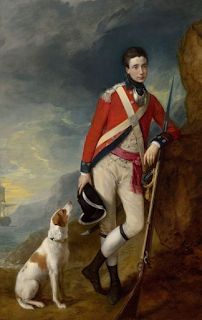 Dear Diary:In the Words of Lieutenant Michael Sanders
Dear Diary:In the Words of Lieutenant Michael Sanders(Children of the Shawnee: Lies and Deceit)
Dear Diary,
It has been a long day and an even longer week, if that is possible. The past few months I have spent organizing the men and preparing for the inevitable war with the Shawnee. I know it will only be a matter of time before they should attack our fort yet again. Each day, I wake up wondering if this will be the day or not. The longer I wait the more anxious I become. Thankfully, I have my beloved Rachel by my side. Lord Dunmore has made it quite clear the only females allowed at the station are the underaged daughters of soldiers or their wives. Rachel and I were quickly wed by a local Anglican minister so we could remain together. I am eternally grateful to Lord Dunmore for his ruling. I have been wanting to marry her for sometime but my military duties and station had prevented me from doing so. We are both so delighted to be together that there isn't a night where we don't give into our marital responsibilities.
This morning, Rachel delivered a most disturbing order to me. It seems Lord Dunmore has requested my presence in his office. The order came within a day since I had received a letter from my father. My father has requested that I be transferred to Boston. While I would love Rachel to meet my family, I do not think it would be wise for me to transfer back home. It's only been four years since I ordered my men to shoot into the civilian mob. I was fortunate to escape from punishment for the Boston Massacre but the Sons of Liberty haven't forgotten. The demand that I hang for murder. I am quiet certain, should I return to Boston they will leave my wife a widow. Let us hope to God Lord Dunmore doesn't accept my father's request.
I must go. I hear General Braddox calling for me. Michael Sanders
Published on August 13, 2016 13:37
August 12, 2016
#CelebratetheSmallBlessings: #Glaucoma, #Cataracts and Legally Blind Blessings

This week has been a week of blessings for my family. It's amazing how small blessings can add up to bigger ones.
The biggest blessing my husband and I received this week came as a big surprise. He was told a few months ago that he had a secondary cataract behind the artificial lens in his left eye and a cataract in his right eye. We've known about the cataract in the right eye for six years. My husband has glaucoma and none of the specialists we have ever seen wanted to remove the cataract in the right eye.
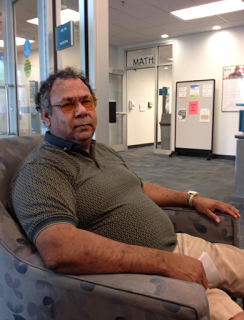 My husband had seen an eye surgeon a month ago. She had recommended that he see a glaucoma
My husband had seen an eye surgeon a month ago. She had recommended that he see a glaucoma specialist to see if there is anything else that needs to be done. She also said he needed to have surgery to remove both cataracts. My husband has end stage glaucoma. He's had a shunt placed in his left eye and a blub in his right eye. The last doctor we had seen said there was nothing more they could do for my husband. He was declared legally blind in 2010 due to the end stage glaucoma.
Yesterday, we had thought his trip to the glaucoma specialist was going to be futile. My husband has been working with the Texas Department of the Blind. They had told him after they receive the recommendation from the glaucoma specialist that they would schedule his operations. We live three hours south of El Paso, where all the doctors are. My husband and his best friend drove to El Paso while I remained in Marfa. I couldn't leave my work and school. Imagine my surprise when the glaucoma specialist's office called me asking for my husband. I told them he was in their office. They said he had just left and the doctor had arranged for the cataract in the right eye to be removed that very day.
I called my husband. He told me they had removed the cataract in the left eye while he was there and was shocked that they had moved so quickly to have the right eye done. He hung up the phone and went to the surgery center. When he came home, later that night, he told me that the cataract in the right eye had been so large that the medical students were talking about. I am so grateful for the doctors who saw the urgency in the removal of the cataracts. My husband had been anxious and frustrated with all the delays before yesterday. He has a follow up in ten days with an eye doctor that is closer to us.
Published on August 12, 2016 11:05
August 8, 2016
Ohio's Archaic Heritage: Burial Customs #NativeAmerican #Ohio #history
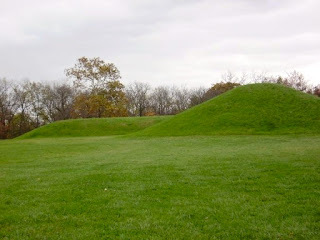 Burial Mounds by Allison BruningOhio's Archaic Heritage:Burial Customs
Burial Mounds by Allison BruningOhio's Archaic Heritage:Burial CustomsWelcome back to Ohio's Archaic Heritage. We have walked alongside our ancestors as they had to adapt to the climatic and geographical changes that beset upon them after the glaciers retreated back into Canada. As we learned in the previous posts, humans adapted quite well to their glacial free environment. They not only developed the atlatl and new hunting techniques but also began to settle down into a semi-sedentary lifestyle. Their sedentary lifestyle also lead to social changes that would remain a part of the Native American culture. These cultural changes included the adaptation of animal clans, participation in religious ceremonies, sacred objects, tribal affiliations, and a semi-nomadic lifestyle based on the seasons.
The change from a Paleoindian to Archaic lifestyle did not happen overnight but was a gradual transition that occurred from the Early Archaic period to the Late Archaic period. The first Archaic Native Americans to have dwelt on the Black River Watershed in Ohio arrived on Lake Erie's southern shore around 6,500 years ago. Known as Canesadooharie or River of Many Pearls by the Wyandot Nation, the Black River is a twelve mile long river in Northern Ohio whose mouth meets Lake Erie. It is considered part of Saint Lawrence Watershed and runs to the Atlantic Ocean via Lake Erie, Niagara River, and Lake Ontario. It was this group of Archaic Native Americans that were first to proficiently harvest roots, berries, tubers, leaves, and nuts. They were also the first group to cultivate squash. We will talk later about early cultivation.
Another group of Archaic Native Americans that is very well known in Ohio are the Glacial or Gravel
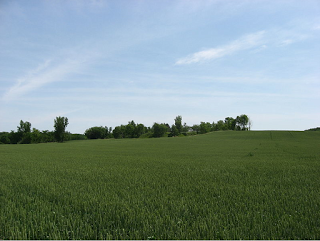 The Zimmerman Kame Site in Hardin County, Ohio
The Zimmerman Kame Site in Hardin County, OhioUS PUBLIC DOMAINKame Native Americans. The Glacial Kame Native Americans occupied Ohio between 8000 BC to 1000 BC. Archaeological records show this was a large tribe with villages spanning throughout southern Ontario, Michigan, Ohio and Indiana. The first Glacial Kame site discovered in Ohio occurred in 1856 near the village of Ridgeway in Hardin County, Ohio. The group was named Glacial Kame because they buried their dead in glacial kames, small hills of gravel, and sand deposited by glaciers. Archaeologists discovered Archaic 380 burials, which they removed from the site. Relics alongside the bodies included heavy copper beads, sole and saucer shaped ornaments of shell, masks made from skulls of wolves and bears and images of birds carved from hard slate. Hardin County has many Archaic Archaeological sites.
One of the most significant changes from Paleoindian to Archaic lifestyles was the burial of the dead. Every Archaic culture had developed their own scared rituals of burying their dead. Where the dead were buried was based on clan, family or social status. The Archaic people chose a specific site to bury their dead and would bring their dead to that site even if it meant it was miles away from where that person had died. Large cemeteries were established throughout Ohio and were used for extended period of time. For example, The University of Toledo archaeologists found 18 burial pits from the Williams site along the Maumee River that had been in use from 850 to 380 B.C. That's nearly 500 years! These cemeteries were often in the form of burial mounds. Burial mounds were constructed by the entire community. We will talk more about burial mounds in our next series: The Moundbuilders.
Published on August 08, 2016 21:00



